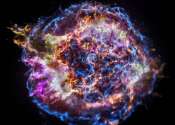New study proves Moon was created in massive planetary collision
(Phys.org)—It's a big claim, but Washington University in St. Louis planetary scientist Frédéric Moynier says his group has discovered evidence that the Moon was born in a flaming blaze of glory when a body the size of ...









